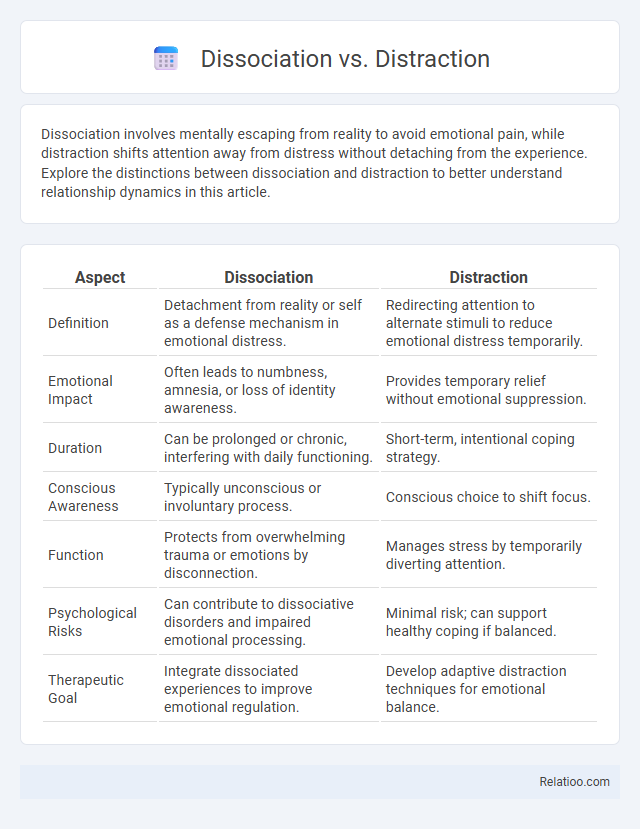Dissociation involves mentally escaping from reality to avoid emotional pain, while distraction shifts attention away from distress without detaching from the experience. Explore the distinctions between dissociation and distraction to better understand relationship dynamics in this article.
Table of Comparison
| Aspect | Dissociation | Distraction |
|---|---|---|
| Definition | Detachment from reality or self as a defense mechanism in emotional distress. | Redirecting attention to alternate stimuli to reduce emotional distress temporarily. |
| Emotional Impact | Often leads to numbness, amnesia, or loss of identity awareness. | Provides temporary relief without emotional suppression. |
| Duration | Can be prolonged or chronic, interfering with daily functioning. | Short-term, intentional coping strategy. |
| Conscious Awareness | Typically unconscious or involuntary process. | Conscious choice to shift focus. |
| Function | Protects from overwhelming trauma or emotions by disconnection. | Manages stress by temporarily diverting attention. |
| Psychological Risks | Can contribute to dissociative disorders and impaired emotional processing. | Minimal risk; can support healthy coping if balanced. |
| Therapeutic Goal | Integrate dissociated experiences to improve emotional regulation. | Develop adaptive distraction techniques for emotional balance. |
Understanding Dissociation: Definition and Symptoms
Dissociation involves a detachment from reality, marked by symptoms such as memory gaps, a sense of unreality, and identity confusion. Unlike distraction, which temporarily shifts attention away from stressors, dissociation disrupts your normal consciousness and can impair daily functioning. Recognizing these signs is crucial to differentiate dissociation from harmful coping mechanisms that may exacerbate psychological distress.
What is Distraction? Key Features and Examples
Distraction is a coping mechanism that redirects your attention away from distressing thoughts or emotions by focusing on external stimuli or engaging activities. Key features include temporary relief without addressing underlying issues, involvement in hobbies, social interactions, or tasks, and the ability to break negative thought cycles momentarily. Examples of distraction include watching movies, exercising, or playing video games to shift focus from stress or anxiety.
Psychological Mechanisms Behind Dissociation
Dissociation involves a disruption in the normal integration of consciousness, memory, and identity, often triggered by trauma as a protective psychological mechanism. Unlike distraction, which shifts attention away from stressors temporarily, dissociation creates a detachment from reality or self-awareness, serving as an automatic defense against overwhelming emotional pain. Harmful coping strategies, however, typically involve maladaptive behaviors without the distinct neurological and cognitive fragmentation characteristic of dissociative responses.
How Distraction Works in Daily Life
Distraction works in daily life by temporarily diverting your attention away from stressors or negative emotions, allowing your mind to focus on more neutral or positive stimuli. Unlike harmful coping mechanisms that may worsen your mental health, healthy distraction techniques--such as engaging in hobbies, physical activity, or social interactions--help reduce anxiety and improve mood. Effective distraction offers a practical way to manage immediate emotional discomfort without avoiding or suppressing the underlying issues permanently.
Dissociation vs Distraction: Core Differences
Dissociation involves a psychological detachment from reality, often characterized by a loss of awareness or memory gaps, whereas distraction refers to shifting attention away from distressing thoughts or stimuli without losing contact with reality. Dissociation typically serves as a protective mechanism in response to trauma or extreme stress, leading to altered consciousness, while distraction is a conscious effort to manage stress through engagement with external activities or stimuli. Understanding these core differences is essential for effective therapeutic intervention, as dissociation may require trauma-focused treatment, whereas distraction strategies can be part of healthy coping skills.
Effects on Mental Health and Wellbeing
Dissociation involves a detachment from reality, often causing gaps in memory and impairing emotional processing, which can exacerbate anxiety, depression, and PTSD symptoms. Distraction temporarily shifts attention away from stressors, offering relief but failing to address underlying issues, potentially leading to unresolved mental health challenges. Your ability to recognize harmful coping strategies, such as avoidance or substance abuse, is crucial for maintaining long-term mental wellbeing and fostering healthier emotional resilience.
When Dissociation Becomes a Concern
Dissociation becomes a concern when it disrupts your ability to function in daily life, causing memory gaps, emotional numbness, or detachment from reality. Unlike distraction, which temporarily shifts your focus, dissociation can lead to ongoing difficulties with identity and emotional regulation. Harmful coping strategies may worsen dissociation by fostering avoidance rather than addressing underlying trauma or stress.
Practical Uses of Healthy Distraction
Healthy distraction serves as a practical coping mechanism by redirecting Your focus from distressing thoughts without causing dissociation, which involves detachment from reality. Unlike harmful coping strategies that may temporarily mask problems but exacerbate emotional pain, healthy distractions such as engaging in hobbies, physical activity, or mindfulness exercises promote emotional regulation and mental resilience. Utilizing these positive distractions can help maintain grounding in the present moment while reducing stress and preventing overwhelming feelings.
Coping Strategies: Choosing Between Dissociation and Distraction
Dissociation and distraction represent distinct coping strategies with different psychological impacts; dissociation involves detaching from reality to avoid trauma, often exacerbating mental health issues, while distraction temporarily redirects attention away from stress without altering emotional processing. Harmful coping mechanisms, including excessive substance use or self-harm, pose risks by providing short-term relief but long-term damage. Selecting adaptive coping methods, such as mindful distraction techniques, fosters emotional regulation and resilience, promoting healthier psychological outcomes compared to dissociation or harmful responses.
Seeking Professional Help: Treatment and Support
Seeking professional help is crucial for effective treatment of dissociation, distraction, and harmful coping mechanisms, as mental health experts offer tailored therapies such as cognitive-behavioral therapy (CBT) and trauma-focused interventions. Support systems, including counseling, support groups, and psychiatric care, provide strategies to manage symptoms and foster resilience. Early intervention enhances recovery outcomes by addressing underlying issues and promoting healthy coping skills.

Infographic: Dissociation vs Distraction
 relatioo.com
relatioo.com